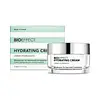What's inside
What's inside
 Key Ingredients
Key Ingredients

 Benefits
Benefits

 Concerns
Concerns

 Ingredients Side-by-side
Ingredients Side-by-side

Water
Skin ConditioningCaprylic/Capric Triglyceride
MaskingButylene Glycol
HumectantC12-20 Acid PEG-8 Ester
EmulsifyingCetyl Alcohol
EmollientTocopherol
AntioxidantPhenoxyethanol
PreservativeSodium Hyaluronate
HumectantEthylhexylglycerin
Skin ConditioningCarbomer
Emulsion StabilisingSorbitan Oleate
EmulsifyingPotassium Sorbate
PreservativePotassium Hydroxide
BufferingCitric Acid
BufferingHordeum Vulgare Seed Extract
Skin ConditioningSh-Oligopeptide-1
Skin ConditioningWater
Skin ConditioningGlycerin
HumectantPropanediol
SolventCetyl Ethylhexanoate
EmollientCaprylic/Capric Triglyceride
MaskingPolymethyl Methacrylate
Oxygen
Skin ConditioningCeramide Ng
Skin ConditioningLinoleic Acid
CleansingLinolenic Acid
CleansingGlycyrrhiza Glabra Root Extract
BleachingChrysanthemum Parthenium Extract
Skin ConditioningCamellia Sinensis Leaf Extract
AntimicrobialSodium Hyaluronate
HumectantTocopherol
AntioxidantColloidal Oatmeal
AbsorbentCaprylyl Glycol
EmollientHydrolyzed Yeast Extract
Skin ConditioningCetyl Hydroxyethylcellulose
Emulsion StabilisingCholesterol
EmollientPolyglucuronic Acid
Skin ConditioningCetyl Alcohol
EmollientSodium Polyacrylate Starch
AbsorbentStearic Acid
CleansingDipropylene Glycol
HumectantSodium Acrylate/Sodium Acryloyldimethyl Taurate Copolymer
Emulsion StabilisingGlyceryl Stearate
EmollientSodium Polyacrylate
AbsorbentPolypropylene
Polysorbate 80
EmulsifyingSteareth-30
CleansingLecithin
EmollientEthylhexylglycerin
Skin ConditioningLeuconostoc/Radish Root Ferment Filtrate
AntimicrobialPhenoxyethanol
PreservativePerfluorohexane
SolventChlorphenesin
AntimicrobialPerfluoromethylcyclopentane
Skin ConditioningSodium Benzoate
MaskingPotassium Sorbate
PreservativeWater, Glycerin, Propanediol, Cetyl Ethylhexanoate, Caprylic/Capric Triglyceride, Polymethyl Methacrylate, Oxygen, Ceramide Ng, Linoleic Acid, Linolenic Acid, Glycyrrhiza Glabra Root Extract, Chrysanthemum Parthenium Extract, Camellia Sinensis Leaf Extract, Sodium Hyaluronate, Tocopherol, Colloidal Oatmeal, Caprylyl Glycol, Hydrolyzed Yeast Extract, Cetyl Hydroxyethylcellulose, Cholesterol, Polyglucuronic Acid, Cetyl Alcohol, Sodium Polyacrylate Starch, Stearic Acid, Dipropylene Glycol, Sodium Acrylate/Sodium Acryloyldimethyl Taurate Copolymer, Glyceryl Stearate, Sodium Polyacrylate, Polypropylene, Polysorbate 80, Steareth-30, Lecithin, Ethylhexylglycerin, Leuconostoc/Radish Root Ferment Filtrate, Phenoxyethanol, Perfluorohexane, Chlorphenesin, Perfluoromethylcyclopentane, Sodium Benzoate, Potassium Sorbate
 Reviews
Reviews

Ingredients Explained
These ingredients are found in both products.
Ingredients higher up in an ingredient list are typically present in a larger amount.
This ingredient is an emollient, solvent, and texture enhancer. It is considered a skin-softener by helping the skin prevent moisture loss.
It helps thicken a product's formula and makes it easier to spread by dissolving clumping compounds.
Caprylic Triglyceride is made by combining glycerin with coconut oil, forming a clear liquid.
While there is an assumption Caprylic Triglyceride can clog pores due to it being derived from coconut oil, there is no research supporting this.
Learn more about Caprylic/Capric TriglycerideCetyl Alcohol is a fatty alcohol. Fatty Alcohols are most often used as an emollient or to thicken a product.
Its main roles are:
Though it has "alcohol" in the name, it is not related to denatured alcohol or ethyl alcohol.
The FDA allows products labeled "alcohol-free" to have fatty alcohols.
Learn more about Cetyl AlcoholEthylhexylglycerin (we can't pronounce this either) is commonly used as a preservative and skin softener. It is derived from glyceryl.
You might see Ethylhexylglycerin often paired with other preservatives such as phenoxyethanol. Ethylhexylglycerin has been found to increase the effectiveness of these other preservatives.
Phenoxyethanol is a preservative that has germicide, antimicrobial, and aromatic properties. Studies show that phenoxyethanol can prevent microbial growth. By itself, it has a scent that is similar to that of a rose.
It's often used in formulations along with Caprylyl Glycol to preserve the shelf life of products.
Potassium Sorbate is a preservative used to prevent yeast and mold in products. It is commonly found in both cosmetic and food products.
This ingredient comes from potassium salt derived from sorbic acid. Sorbic acid is a natural antibiotic and effective against fungus.
Both potassium sorbate and sorbic acid can be found in baked goods, cheeses, dried meats, dried fruit, ice cream, pickles, wine, yogurt, and more.
You'll often find this ingredient used with other preservatives.
Learn more about Potassium SorbateSodium Hyaluronate is hyaluronic acid's salt form. It is commonly derived from the sodium salt of hyaluronic acid.
Like hyaluronic acid, it is great at holding water and acts as a humectant. This makes it a great skin hydrating ingredient.
Sodium Hyaluronate is naturally occurring in our bodies and is mostly found in eye fluid and joints.
These are some other common types of Hyaluronic Acid:
Learn more about Sodium HyaluronateTocopherol (also known as Vitamin E) is a common antioxidant used to help protect the skin from free-radicals and strengthen the skin barrier. It's also fat soluble - this means our skin is great at absorbing it.
Vitamin E also helps keep your natural skin lipids healthy. Your lipid skin barrier naturally consists of lipids, ceramides, and fatty acids. Vitamin E offers extra protection for your skin’s lipid barrier, keeping your skin healthy and nourished.
Another benefit is a bit of UV protection. Vitamin E helps reduce the damage caused by UVB rays. (It should not replace your sunscreen). Combining it with Vitamin C can decrease sunburned cells and hyperpigmentation after UV exposure.
You might have noticed Vitamin E + C often paired together. This is because it is great at stabilizing Vitamin C. Using the two together helps increase the effectiveness of both ingredients.
There are often claims that Vitamin E can reduce/prevent scarring, but these claims haven't been confirmed by scientific research.
Learn more about TocopherolWater. It's the most common cosmetic ingredient of all. You'll usually see it at the top of ingredient lists, meaning that it makes up the largest part of the product.
So why is it so popular? Water most often acts as a solvent - this means that it helps dissolve other ingredients into the formulation.
You'll also recognize water as that liquid we all need to stay alive. If you see this, drink a glass of water. Stay hydrated!
Learn more about Water